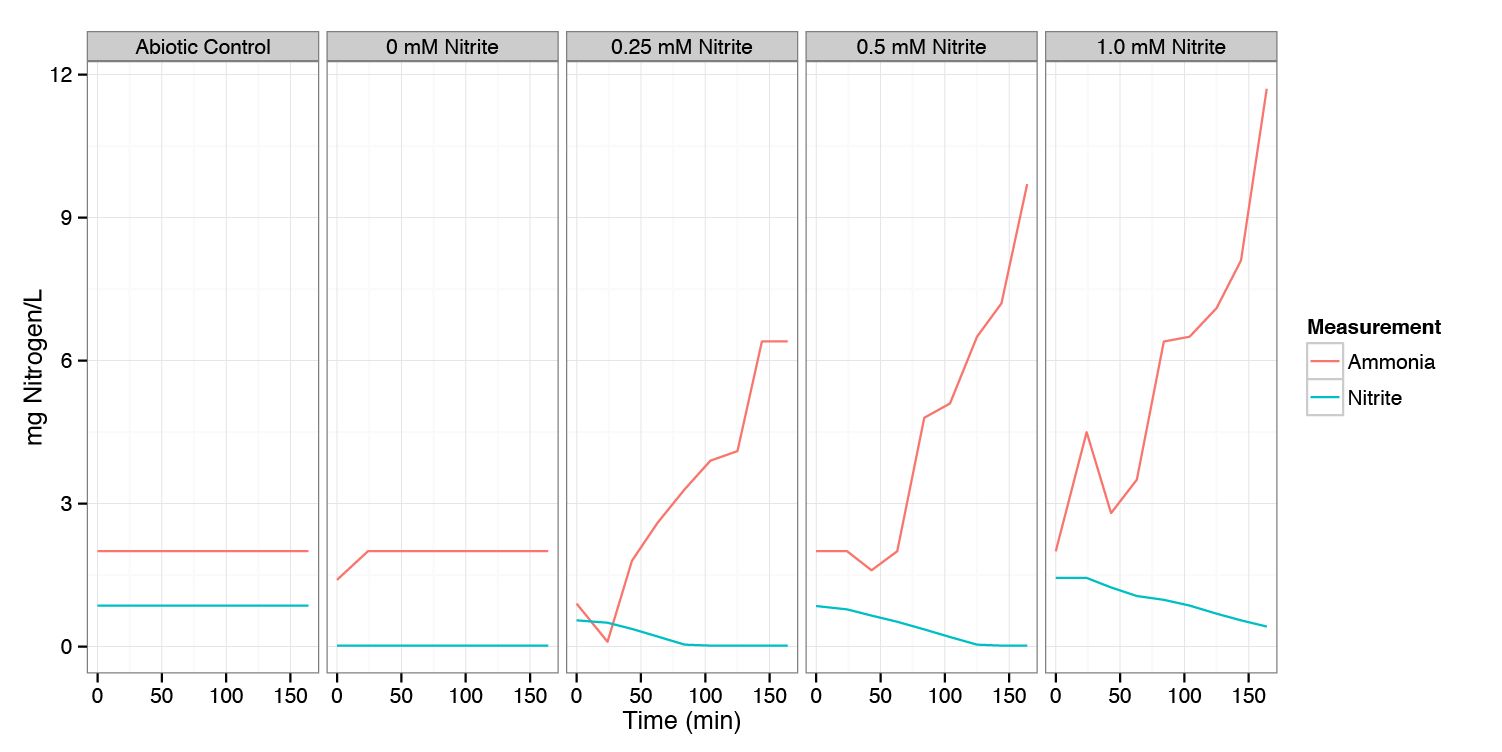Team:DTU-Denmark/Experiment1a
From 2013.igem.org
| Line 3: | Line 3: | ||
== Description == | == Description == | ||
| - | The aim of | + | The aim of this experiment is to characterize the conversion of nitrite to ammonium in wild type ''E.coli'' under anaerobic conditions. |
| - | The experiment was performed by adding three different concentrations of nitrite to a medium with a growing native strain of ''E. coli''. The concentrations of NH<sub>4</sub><sup>+</sup> and NO<sub>2</sub><sup>-</sup> were measured every 20 minutes and the experiment lasted for 3 hours. Also | + | The experiment was performed by adding three different concentrations of nitrite to a medium with a growing native strain of ''E. coli''. The concentrations of ammonium (NH<sub>4</sub><sup>+</sup>) and nitrite (NO<sub>2</sub><sup>-</sup>) were measured every 20 minutes and the experiment lasted for 3 hours. Also two controls: with biomass only (no nitrite) and without biomass were analyzed in order to exclude any external influences on the nitrite conversion. |
== Methods == | == Methods == | ||
| Line 16: | Line 16: | ||
Mg of Nitrogen (as Nitrite or Ammonia) per litre measured for varying concentrations of Nitrite added at t=0. All experiments were performed anaerobically. Samples were measured every 20 min for 3 hours. | Mg of Nitrogen (as Nitrite or Ammonia) per litre measured for varying concentrations of Nitrite added at t=0. All experiments were performed anaerobically. Samples were measured every 20 min for 3 hours. | ||
| + | |||
| + | == Conclusions and Discussion == | ||
| + | |||
| + | Under anaerobic conditions, nitrite is consumed and converted to ammonium. Since we want to convert the nitrite to nitrous oxide, a functional prototype will require either that the pathway to nitrous oxide be designed to outcompete this pathway, or that this pathway that consumes nitrite be knocked out (and the transformants grown in a medium in which they will not have a need to synthesize ammonium from nitrite. | ||
| + | |||
Revision as of 16:05, 28 September 2013
Experiment 1a
Contents |
Description
The aim of this experiment is to characterize the conversion of nitrite to ammonium in wild type E.coli under anaerobic conditions.
The experiment was performed by adding three different concentrations of nitrite to a medium with a growing native strain of E. coli. The concentrations of ammonium (NH4+) and nitrite (NO2-) were measured every 20 minutes and the experiment lasted for 3 hours. Also two controls: with biomass only (no nitrite) and without biomass were analyzed in order to exclude any external influences on the nitrite conversion.
Methods
Protocol [1]
Results
Mg of Nitrogen (as Nitrite or Ammonia) per litre measured for varying concentrations of Nitrite added at t=0. All experiments were performed anaerobically. Samples were measured every 20 min for 3 hours.
Conclusions and Discussion
Under anaerobic conditions, nitrite is consumed and converted to ammonium. Since we want to convert the nitrite to nitrous oxide, a functional prototype will require either that the pathway to nitrous oxide be designed to outcompete this pathway, or that this pathway that consumes nitrite be knocked out (and the transformants grown in a medium in which they will not have a need to synthesize ammonium from nitrite.
 "
"





